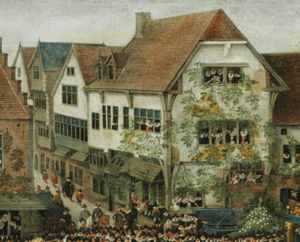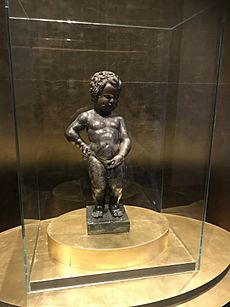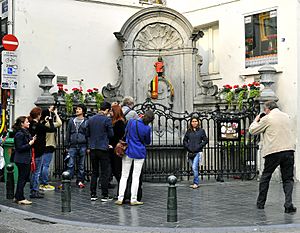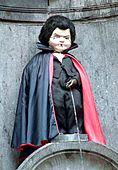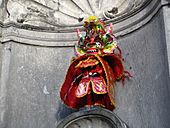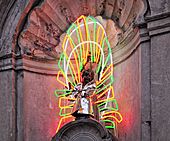Manneken Pis facts for kids
Quick facts for kids Manneken Pis |
|
|---|---|
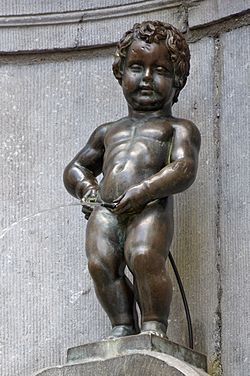 |
|
| Artist | Jérôme Duquesnoy the Elder |
| Year |
|
| Type | Bronze |
| Subject | Puer mingens |
| Dimensions | 55.5 cm (21.9 in) |
| Location | City of Brussels, Brussels-Capital Region, Belgium |
| 50°50′42″N 4°21′00″E / 50.8449861°N 4.3499932°E | |
The Manneken Pis (which means "Little Pissing Man" in Dutch) is a famous bronze statue in the center of Brussels, Belgium. It shows a small, naked boy peeing into a fountain. This statue is only about 55.5 centimeters (22 inches) tall.
Even though people knew about a similar statue as early as the mid-1400s, the one you see today was made by a sculptor named Jérôme Duquesnoy the Elder. It was put in place around 1618 or 1619. The stone archway behind it was added in 1770.
The Manneken Pis has been stolen or damaged many times over the years. Since 1965, the statue on display is actually a copy. The original is kept safe in the Brussels City Museum. This little peeing boy is one of the most famous symbols of Brussels and Belgium. It has inspired many other similar statues around the world.
A fun fact about Manneken Pis is that he often wears different outfits! He has a huge collection of about one thousand costumes. The statue is also a symbol of Belgian humor and identity.
You can find Manneken Pis about a five-minute walk from the Grand-Place, which is Brussels' main square. It's located where the Rue du Chêne and Rue de l'Étuve streets meet.
Contents
What does "Manneken Pis" mean?
The original name of the statue was Menneke Pis. In the old Brussels dialect, een manneke meant a small man. But een menneke meant a little boy. Today, the name Manneken Pis is official in both French and Dutch. It simply means "Little Pissing Man."
Sometimes, people call Manneken Pis by the nickname Petit Julien in French or Julianske in Dutch. Both names mean "Little Julien." This name comes from a mix-up by historians in the 1800s. They confused the statue with another nearby fountain that was called "Little Julien."
Because of its long history, the statue is also sometimes called "the oldest citizen of Brussels."
History of the Statue
How old is Manneken Pis?
The first time anyone wrote about Manneken Pis was in a document from 1451–52. This document was about the water pipes that supplied Brussels' fountains. From the very beginning, the fountain helped provide drinking water to the city.
The first statue stood on a tall column and poured water into a stone basin. Old maps and paintings show this early version. For example, a painting from 1616 by Denis Van Alsloot shows Manneken Pis dressed as a shepherd.
The city council of Brussels ordered a new bronze statue in 1619. This is the version we know today. It was made by the sculptor Jérôme Duquesnoy the Elder. The new statue was likely put in place in 1620. At the same time, the column and water basin were also rebuilt.
What happened to Manneken Pis over time?
Throughout its history, Manneken Pis has faced many challenges. It survived the bombing of Brussels by the French army in 1695 without damage. However, the water pipes were broken, so it couldn't pee for a while.
A paper written that same year said that Manneken Pis had become "an object of glory appreciated by all." This was the first time the statue was seen as a symbol for the people of Brussels. After the bombing, people say it was proudly put back on its stand. A Latin phrase was even written above its head, meaning: "The Lord placed me on a stone base, and now I raise my head above my enemies."
In 1770, the old column and basin were removed. The statue was then placed in a new stone archway. This new setting made the statue look smaller than before. The whole area around the statue was protected by railings, with the latest ones added in 1851. These railings stopped people from getting water directly from the fountain. This was because Brussels started providing drinking water to homes around that time.
The statue has been stolen or attempts have been made to steal it many times. A story says it was taken in 1745 and found in the town of Geraardsbergen. Because of this, the people of Brussels gave Geraardsbergen a copy of the statue.
In 1747, French soldiers tried to steal it. The people of Brussels were very angry! To calm them down, the King of France, Louis XV, gave Manneken Pis a fancy gold-embroidered suit. He also allowed the statue to carry a sword and gave it a special medal.
The statue was stolen again in 1817 by a man named Antoine Licas. He was punished severely. The original statue broke into eleven pieces during this theft. A special welder fixed it, and the pieces were used to make a mold for a new bronze statue. The statue was then screwed onto a new base that said "1620 – REST 1817."
Manneken Pis in the 20th century and today
Manneken Pis continued to have adventures in the 1900s. There were two attempts to steal it in 1955 and 1957. Some stories say it has been stolen up to seven times! In 1963, some students "hijacked" the statue for five days. They later gave it back, and the story helped them raise money for orphanages.
Things got more serious when the statue disappeared in 1965. The thief broke the statue, leaving only its feet and ankles. In June 1966, the statue's "body" was found in the Charleroi Canal. It was brought back to Brussels and fixed again.
After this, the original statue was moved to a safe place. You can now see it on the second floor of the Brussels City Museum. A new copy of the statue was made and put in its place. This is the statue you see in the niche on the Rue du Chêne today.
In late 2018, it was discovered that the statue's basin had a leak. This meant that a lot of water was being wasted every day. The leak was fixed temporarily in 2019. A new system is planned to reuse the water, so it doesn't get wasted.
Fun Traditions
Why does Manneken Pis wear costumes?
Manneken Pis is dressed in different costumes several times a week. There's a schedule posted near the fountain so you can see when he'll change outfits.
Since 1954, a group called The Order of the Friends of Manneken Pis manages his costumes. They look at hundreds of designs each year and choose a few to be made. The statue has about one thousand different costumes! Many of these can be seen at a special museum called Garderobe MannekenPis, which opened in 2017.
The idea of dressing Manneken Pis is very old. The first time he was dressed up was in 1615. He wore a shepherd's costume for a special parade. In 1698, he received his first official costume from a ruler named Maximilian II Emanuel. The oldest costume still around was given by King Louis XV of France in the 17th century.
In 1756, the statue had five complete costumes. By 1940, he had about thirty. But after 1945, the number of costumes grew a lot! He had over 400 in 1994 and more than 950 by 2016.
Changing the statue's costume is a colorful event. It often happens with brass band music playing. Many costumes represent different countries or jobs. There are also historical outfits and modern ones, like Dracula, Mickey Mouse, and Santa Claus.
What is the Order of the Friends of Manneken Pis?
The Order of the Friends of Manneken Pis was started in 1954. It has more than 150 members. This group works to promote Belgian culture and tourism. They also help keep the traditions linked to Manneken Pis alive. The Order is always present during ceremonies when new costumes are given to the statue.
On some special occasions, Manneken Pis is connected to a keg of beer! Cups are filled with beer flowing from the statue and given to people passing by.
-
Manneken Pis dressed as Dracula (15 March 2002)
-
Manneken Pis dressed as a burgomaster from the Seven Noble Houses of Brussels (902nd costume, 22 June 2013
-
A saxophone for Manneken Pis on the 200th birthday of Adolphe Sax (6 November 2014)
Copies and Similar Statues
Are there other Manneken Pis statues in Belgium?
While the Manneken Pis in Brussels is the most famous, there are other similar statues across Belgium. People started making copies for decoration as early as the 1600s. The Brussels City Museum has a copy made in 1630. Other similar statues can be found in Belgian cities like Koksijde, Hasselt, Ghent, and Bruges. There's also one in Braine-l'Alleud called El Gamin Quipiche, which means "The Peeing Kid."
Which Manneken Pis is the oldest?
There's a friendly argument about which Manneken Pis is older: the one in Brussels or the one in Geraardsbergen.
The town of Geraardsbergen says their statue was made in 1459. This was after their city was damaged in a war. Their statue was made to replace a lion's head spout that was stolen from a fountain.
The first mention of Brussels' Manneken Pis is from 1451–52. So, it seems there was a "peeing boy" statue in Brussels even before Geraardsbergen's. However, the *design* of Geraardsbergen's original statue (1459) is older than the *design* of Duquesnoy's statue in Brussels (1619). Today, both statues are actually copies: Brussels' is from 1965, and Geraardsbergen's is from 1985.
Are there Manneken Pis statues around the world?
Since the 1900s, many copies of Manneken Pis have been made in other countries. Some are official copies given by the City of Brussels. Others are made by people who admire the statue.
Official copies have been given to cities like:
 Colmar, France (1921)
Colmar, France (1921) Osaka, Japan (1928)
Osaka, Japan (1928) Monaco (1951)
Monaco (1951) London, United Kingdom (1959)
London, United Kingdom (1959) Broxeele, France (1979)
Broxeele, France (1979) Benalmadena, Spain (1991)
Benalmadena, Spain (1991) Nagoya, Japan (2015)
Nagoya, Japan (2015)
A copy of Manneken Pis is in the police station lobby in Poitiers, France. This is to remember that the Belgian government was based there for a short time during World War II.
Other copies exist in places like Bogense, Denmark, and Chiayi Park in Taiwan. There's also a working copy on a train platform in Tokyo, Japan, at Hamamatsuchō Station. The station workers there are very proud of it and dress it in different costumes throughout the year.
In 2002, a waffle-maker from Belgium put a copy of the statue in front of his shop in a mall in Orlando, Florida. Some shoppers were surprised and complained.
In Rio de Janeiro, Brazil, there's a similar statue in front of a famous football club's headquarters. The club's fans think it's funny and have even made it their mascot. They often dress it in the club's jersey after big wins.
See also
 In Spanish: Manneken Pis para niños
In Spanish: Manneken Pis para niños
- Sculpture in Brussels
- History of Brussels


